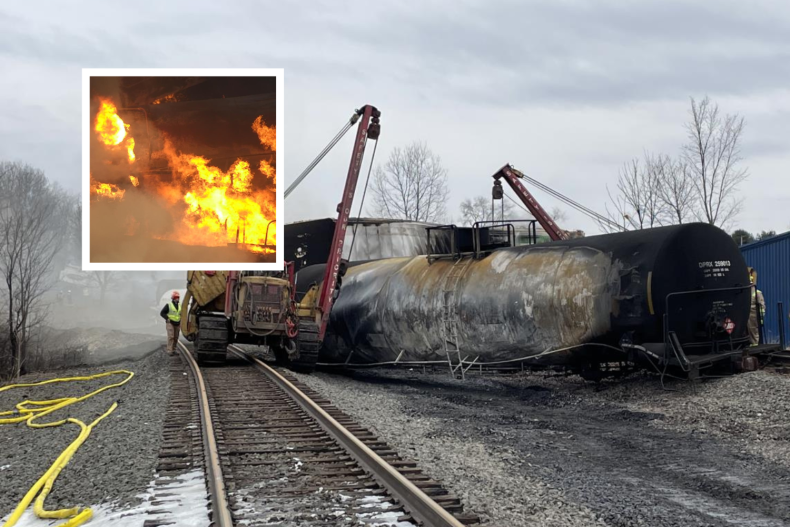Ohio Train Derailment Aftermath: Prolonged Presence Of Toxic Chemicals In Buildings

Table of Contents
Contamination Pathways: How Toxic Chemicals Entered Buildings
The release of vinyl chloride and other hazardous materials during the Ohio train derailment led to widespread contamination, infiltrating homes and businesses through various pathways. Understanding these pathways is crucial for effective remediation and preventing further exposure.
-
Airborne Dispersion: The initial explosion and subsequent burning of vinyl chloride created a plume of toxic chemicals that were carried by prevailing winds, potentially depositing them on surfaces and inside buildings. The volatile nature of these chemicals allowed for rapid dispersion over a wide area, increasing the extent of contamination. Air quality monitoring data from the time period following the derailment helps to illustrate the range of this airborne dispersion.
-
Surface Contamination: Runoff from rain and snowmelt carried the chemicals deposited on the ground into storm drains and waterways. This runoff could have then contaminated soil, leading to further spread of the toxic substances. Direct deposition of chemicals from the initial release also directly contaminated surfaces.
-
Groundwater Contamination: Leaching of chemicals from the contaminated soil into the groundwater poses a long-term threat. This contamination can affect drinking water supplies and further exacerbate the health risks associated with the derailment. Testing for groundwater contamination is ongoing and crucial for assessing the full extent of the environmental damage.
-
Indirect Contamination via Supply Chains: Materials used in construction or repair work, potentially contaminated by the derailment, could introduce chemicals into buildings indirectly. This necessitates careful investigation of the supply chains used for materials in the affected area.
Health Risks Associated with Prolonged Exposure to Toxic Chemicals
Long-term exposure to the chemicals released in the derailment, including vinyl chloride, presents severe health risks. The potential consequences can be far-reaching and devastating.
-
Respiratory Problems: Vinyl chloride is known to irritate the respiratory system, potentially leading to chronic bronchitis, asthma, and an increased risk of lung cancer. Inhalation of other released chemicals could also cause similar respiratory issues.
-
Neurological Effects: Exposure to these chemicals can manifest in various neurological symptoms, including headaches, dizziness, cognitive impairment, and even more severe neurological disorders. The long-term effects on brain function remain a significant concern.
-
Liver Damage: Vinyl chloride is a known hepatotoxin, meaning it is toxic to the liver. Prolonged exposure can lead to cirrhosis and an increased risk of liver cancer. Other chemicals released in the derailment could also contribute to liver damage.
-
Reproductive and Developmental Issues: Studies have linked exposure to vinyl chloride and other toxic chemicals to reproductive and developmental problems, both in adults and children. This includes birth defects and fertility issues.
-
Cancer Risks: Several types of cancer are associated with prolonged exposure to vinyl chloride and other chemicals released in the derailment. These include liver cancer, lung cancer, and other forms of cancer. Long-term epidemiological studies are needed to fully assess the cancer risk for the affected population.
Challenges in Remediation and Cleanup Efforts
Thoroughly decontaminating buildings affected by the Ohio train derailment presents significant challenges. The scale of the contamination and the complexity of the cleanup process require a multi-pronged approach.
-
Identifying All Affected Areas: Precisely mapping the spread of contamination is critical for targeted remediation efforts. This requires advanced testing and analysis to detect even low levels of toxic chemicals.
-
Removal of Contaminated Materials: In many cases, the removal and disposal of contaminated materials, including soil, building materials, and personal belongings, will be necessary. This process is expensive and logistically complex.
-
Air and Water Purification: Effective filtration systems for air and water are essential to protect residents from continued exposure. This requires ongoing monitoring and maintenance of these systems.
-
Long-Term Monitoring: Regular testing for persistent contamination is crucial to ensure the effectiveness of remediation efforts and to identify any lingering threats. This requires a long-term commitment to environmental monitoring.
-
Regulatory Hurdles and Legal Complexities: Navigating regulations and legal processes related to cleanup and compensation can create significant delays and complications. Clear legal frameworks and accountability are essential.
Long-Term Monitoring and Support for Affected Communities
Ongoing health monitoring and comprehensive support are essential for the affected communities. This requires a long-term commitment from various stakeholders.
-
Comprehensive Health Screenings for Residents: Regular health screenings for all residents in the affected area are vital to identify potential health problems early and provide timely intervention.
-
Provision of Medical Care and Treatment: Access to appropriate medical care and treatment should be readily available to those experiencing health issues related to the chemical exposure.
-
Psychological Support for Affected Individuals and Families: The emotional toll of such a disaster cannot be underestimated. Providing psychological support is vital for mental health and well-being.
-
Financial Assistance for Remediation and Relocation: Financial assistance is crucial to help residents with the costs associated with remediation efforts, relocation, and medical expenses.
-
Continued Environmental Monitoring and Data Transparency: Open access to environmental monitoring data ensures transparency and accountability, allowing communities to make informed decisions about their health and safety.
Conclusion
The prolonged presence of Ohio train derailment toxic chemicals in buildings presents a significant and ongoing threat to public health and the environment. The challenges of remediation are substantial, requiring a coordinated effort involving government agencies, private companies, and the affected communities. The key takeaways are the need for long-term monitoring, comprehensive health assessments, and substantial support for those affected. We must demand accountability from responsible parties and advocate for comprehensive cleanup efforts to address the lingering effects of this environmental disaster. Continued vigilance and sustained action are necessary to mitigate the ongoing risks posed by the Ohio Train Derailment Toxic Chemicals.

Featured Posts
-
 Agression Au Lac Kir A Dijon Bilan Et Circonstances
May 10, 2025
Agression Au Lac Kir A Dijon Bilan Et Circonstances
May 10, 2025 -
 Call For Regulatory Reform Indian Insurers And Bond Forward Markets
May 10, 2025
Call For Regulatory Reform Indian Insurers And Bond Forward Markets
May 10, 2025 -
 Trumps Transgender Military Ban Deciphering The Double Speak
May 10, 2025
Trumps Transgender Military Ban Deciphering The Double Speak
May 10, 2025 -
 Big Wall Street Comeback How Bear Market Bets Are Failing
May 10, 2025
Big Wall Street Comeback How Bear Market Bets Are Failing
May 10, 2025 -
 Why Is The Us Attorney General On Fox News Daily A More Important Question Than Epstein
May 10, 2025
Why Is The Us Attorney General On Fox News Daily A More Important Question Than Epstein
May 10, 2025
